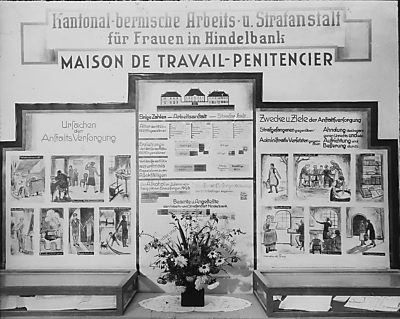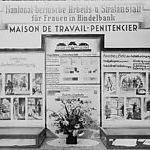The Hindelbank Correctional Labour Facility: A Place of Reformation and Redemption?
 «Kantonal-bernische Arbeits- u. Strafanstalt für Frauen in Hindelbank. Maison de Travail-Penitencier», information board of the Hindelbank women’s prison and correctional labour facility in the Canton of Bern for the Swiss Exhibition of Women's Work [Schweizerische Ausstellung für Frauenarbeit (SAFFA)] in Bern in 1928, illustrated by Marguerite Frey-Surbek
«Kantonal-bernische Arbeits- u. Strafanstalt für Frauen in Hindelbank. Maison de Travail-Penitencier», information board of the Hindelbank women’s prison and correctional labour facility in the Canton of Bern for the Swiss Exhibition of Women's Work [Schweizerische Ausstellung für Frauenarbeit (SAFFA)] in Bern in 1928, illustrated by Marguerite Frey-Surbek Up until well into the second half of the 20th century, there was no physical separation between the inmates of the correctional labour facility (administrative detainees) and those of the prison and correctional facility. Up until around 1960, all inmates were subject to practically the same regime.
Source Context
In 1928, the former Hindelbank prison and correctional labour facility showcased its services in the «social work» section of the Swiss Exhibition of Women's Work (Schweizerische Ausstellung für Frauenarbeit, SAFFA) in Bern. The glass slide shown here is likely all that remains of the original information board. In its annual report, the facility notes as follows in reference to the exhibition: «Our presentation aimed to draw public attention to the reasons for detention at our facility. We also provided statistics and illustrated the purpose of detention and the means by which we seek to achieve our objectives.»
The information board was thus an informative propaganda tool used by the Canton of Bern to illustrate the penalties imposed on women for behaviour that it considered non-conformist. We know who created the information board and when it was created: The signature on the board reveals the artist to be Bernese painter Marguerite Frey-Surbek (1886-1981). The pictorial representation of the women’s institution was thus commissioned to a renowned artist. However, the question remains as to who exactly commissioned the information board and the level of artistic freedom granted: Who decided the form and content? The Canton of Bern’s police department, the facility’s directors or the exhibition organisers? The SAFFA was an exhibition organised by women for women. At any rate, the use of this information board indicates that the women’s associations saw the detention of women in institutions as an appropriate welfare measure.
Source Content
The information board offers an insight into the authorities’ and institutions’ view on non-conformist behaviour and the methods formerly considered effective for correcting what was seen as inappropriate behaviour. The title in the left section of the board reads «Reasons for Detention at the Facility»: Below are portrayals of social predicaments («homelessness», «alcoholism» and «broken families») and behaviour deemed inappropriate in the eyes of the authorities («passion for finery», «prostitution» and «unfitness for work»). The title in the right section reads «Purposes and Objectives of Detention»: Below are depictions of «healthy and productive work», «reading material», «the cultivation of music» and «lectures». The illustrations are gender specific as the Hindelbank facility had traditionally been for women only. Through this portrayal of «inappropriate behaviour» for women and of what were considered effective «correctional measures», a bourgeois, patriarchal understanding of gender roles was being reinforced, and this during the interwar period, namely at a time of growing female self-confidence. The information board’s message of redemption is exaggerated through its design reminiscent of a winged altar. The institution is depicted in the centre section along with statistical data for 1926/27, and a bouquet of flowers is set in front for decoration.
K. Heiniger/Translation
Source
«Kantonal-bernische Arbeits- u. Strafanstalt für Frauen in Hindelbank. Maison de Travail-Penitencier», information board of the Hindelbank women’s prison and correctional labour facility in the Canton of Bern for the Swiss Exhibition of Women's Work (Schweizerische Ausstellung für Frauenarbeit (SAFFA)) in Bern in 1928, illustrated by Marguerite Frey-Surbek.
Signature: Staatsarchiv des Kantons Bern (StABE): V Frauenzentrale 258 Berner Strafanstalt für Frauen Hindelbank (1928).
 next source
next source


